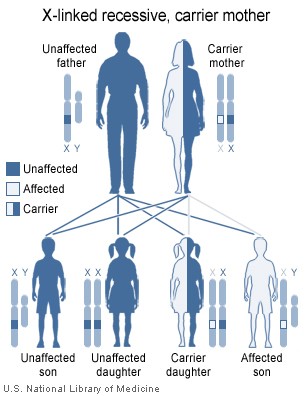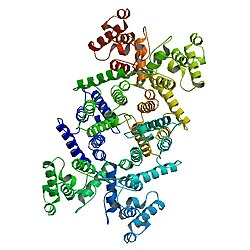
MediaCorp actor Chew Chor Meng, known for his role in the hit sitcom "Don't worry be happy", has been diagnosed with muscular dystrophy. Straits Times Dec 21 2008
Recently there have been a number of newspaper articles on people suffering from Muscular Dystrophy.
When I read about these people, I keep on thinking about colour blindness and haemophilia. These are also congenital (= people born with the trait) diseases). They are due to a mutation in their chromosomes. Their mutations occur on the X-chromosome and so these diseases are called sex-linked diseases.
Sex-linked diseases are more common in the male than in the female. The mother is called a "carrier" as she does not suffer from the disease but passes on the mutated genes to her sons. (If a girl gets the trait, then her father must show the condition and her mother must be a carrier.)
We will now find out the pattern of this unfortunate inheritance.
Colour blindness
This genetic sex-linked disease comes in many forms. The most common is red-green colour blindness.
In this genetic diagram it can be seen that all the daughters do not show the condition. But half the boys (50% of the total number of boys) in the same family will show/suffer from the sex-linked trait.

The colours of the apples in the top row are seen by people with normal colour vision; the bottom by a person who is colour-blind.
Now, here is a quick check for colour-blindness. It is not 100% conclusive.
When white light enters our eyes, it stimulates the nerve cells in the retina. There are many types of cone cells. Each type of cone cell is stimulated by a specific wavelength (=colour of light). If certain cone cells are defective or missing, it results in colour-blindness. For example, if the green sensitive cone cell is not stimulated, then the person does not see green light.
Haemophilia
This genetic sex-linked disease used to result in many fatalities in early history. The children did not live long as they bleed to profusely when they get wounded or cut. They lack certain blood proteins/factors which make it difficult for platelets to stick together, to stop bleeding. Platelets are small colourless cells found in the blood.
A slide show giving a basic explanation of haemophilia, the different types and treatment
It is believed by many historians that haemophilia played a role in precipitating the Russian Revolution in 1917. The son and heir of the last Tsar of Russia had haemophilia. The gene was passed to him by his mother ultimately from his great-grandmother, Queen Victoria of England. The royal families of Europe tended to inter-marry and haemophilia was known as the 'royal disease'.
Muscular dystrophy
In this genetic sex-linked disease, the person slowly loses strength in their muscles.
Symptoms include muscular tremors, cramps, progressing to weakness and wasting in the legs, trunk, arms, shoulders, neck and face. This affects one's walking, speech and swallowing. The disease affects the nervous system that controls the voluntary muscle movements. In advanced stages, the person will be wheelchair-bound, and unable to smile or express his emotions.
This Youtube video shows a young man of 23 years explaining how a mutation on the X-chromosome lead to a lack of a certain protein(dystrophin). This results in his muscle cells turning into connective tissue or fat tissue.
Q: Can sex-linked diseases be cured?
A: No.
All the cells in the body contain the defective X-chromosome. However, people can control the extent to which the condition affects their quality of life. Drugs can be used to control the disease. Regular physiotherapy can alleviate the condition.
In the case of haemophilia, regular transfusion of blood from the blood bank could allow the individual to lead a fairly normal life.
Q: Can sex-linked diseases be avoided?
A: Yes.
Genetic counselling at the hospitals can be sought. If a sex-linked condition has been identified in any family member of the two people wanting to marry, then the couple could work out the chance of giving birth to a child with the condition. The medical workers' advice would be useful to the prospective parents-to-be.
Marriage amongst blood relatives increases the chance of such genetic diseases. These are called consanguineous marriages (marriages where the couple are close blood relatives, e.g. first or second cousins, uncles-nieces, brother-sister). The last is incest, which is punishable by law as this type of pairing will result in their children having many other non-sex linked and even more serious genetic conditions. Repeated consanguineous marriages over several generations, as happened in European royalty, means many more carriers and sufferers are found certain isolated communities or social groups and extended families.
I am feeling sick writing on all these morbid details of incurable genetic diseases.
Signing off.






No comments:
Post a Comment